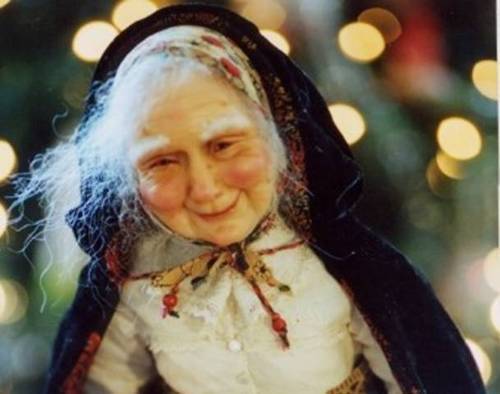
A gift-bringing witch – Italy
In Italy, children are visited by Santa Claus (Babbo Natale) on Christmas Eve,
but also by La Befana on January 5, the eve of the Epiphany. According to the legend,
the witch turned down an invitation from the Three Wise Men to visit baby Jesus in the manger,
and quickly regretted her decision.
The story says that she still flies around looking for baby Jesus
and giving gifts to children to make up for her mistake.
Children often put out a glass of wine and some food for her.

La Befana, Italy
In many countries such as Italy, Spain and Latin American countries, they celebrate the full 12 days of Christmas in the original Christian tradition.
The 12 days of Christmas ends on January 6th with the Feast of the Epiphany. This particular day is important in the bible story as it's when the kings arrive to see the baby who will become Jesus Christ and give their gifts of gold, frankincense and myrrh.
In Italy, they call this moment the 'arrival of the Magi' which is the phrase for the three wise men. 'Magi' in the ancient Persian world meant recognised religious persons such as the equivalent as a priest at that time. 'Magi' is the plural of the word 'Mago'.
Legend has it that before the three kings arrived in Bethlehem they spent a night at the house of an old witch called La Befana. They told her the story of their journey and invited her to join them.
She declined as she was cleaning her home.
Later that night, while asleep, La Befana was awoken by an unusually bright light. Startled and afraid, she took it as a sign to follow the Magi in search of the Christ Child.
Set off to join them with gifts for the baby.
Although she followed the same new star, she was unable to find the manger. She continues to travel the world on Epiphany Eve, searching every house for the child & leaving sweets for good kids & coal for the naughty ones, similar to Santa Claus.
This still has cultural significance now as Italian children leave stockings out for her on the evening of 5th January along with some wine and treats such as a slice of panettone.
Not only is she kind leaving delights for little ones. She is also known for sweeping the house as she leaves, before hopping on her broomstick again.
The reason for this is to sweep away the problems from the previous year! Such a lovely sentiment.
La Befana is usually portrayed as a friendly witch riding a broomstick. She is normally covered in soot because she enters houses through the chimney. It's thought that if one sees La Befana they will receive a thump from her broomstick, as she doesn't wish to be spotted!
Though not well known elsewhere La Befana is celebrated throughout Italy. There are often street parties, parades and many people dress up as elderly witches. The most common places to find big celebrations are Rome, Urbania and Parma.
This is a great day to be in Italy as often churches add the three kings to their nativity displays, there are more Christmas markets and family gatherings. This is still an official holiday in Italy and usually, schools don't resume until after this date.
Italian children also celebrate La Befana with a short nursery rhyme that lives on in their memory long after reaching adulthood. Several variations are well-known throughout the country, but among the most popular versions is:
La Befana vien di notte
con le scarpe tutte rotte
con le toppe alla sottana/con vestito alla romana
viva viva la Befana!
This translates to:
La Befana comes by night
with her shoes all torn
with patches on her skirt/ (alternative verse) dressed in the Roman way
hooray hooray for la Befana!
Read more Stories.